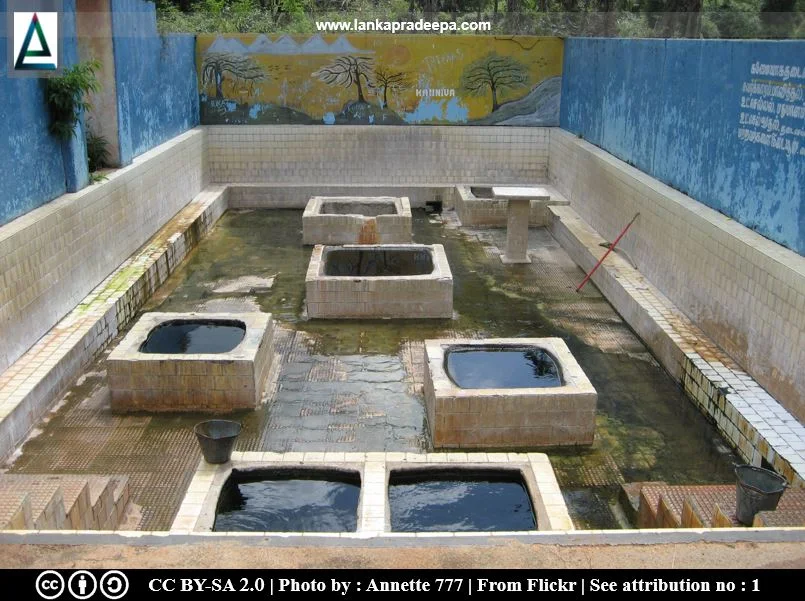
|
Kanniya Hot Springs |
Kanniya Thermal Springs or Kanniya Hot Water Wells (Sinhala: කන්නියා උණුදිය ලිං; Tamil: கன்னியா வெந்நீரூற்று) are located in Trincomalee District, Sri Lanka.
Hot Water Springs
Commonly, thermal springs in the world are associated with volcanic terrain but the hot springs located in Sri Lanka are said to be not related to volcanic activities as the island is not in an active volcanic or tectonic region (Premasiri et al., 2006). Therefore, the waters can get heat either from subsurface heat sources such as large bodies of hot rocks or through deep percolation under the geochemical gradient of the earth (Adikaram & Dharmagunawardhane, 2013). If these waters find weak structural discontinuities leading upward they rise to the surface and emerge as naturally discharging hot water springs.
Kanniya Springs
The Kanniya hot springs are located close to the boundary between Highland-Vijayan lithologic complexes (Premasiri et al., 2006). This boundary is a sub-horizontal ductile thrust zone where a number of geologic features are identified. They include major mineralization occurrences such as magnetite, serpentinite, gold, corundum and calcite as well as formations of hot water springs (Widanagamage, 2011). Seven outflowing hot water wells, each with varying temperatures, are situated close to each other at the site. The average temperature of Kanniya Springs is said to be 42 °C (Premasiri et al., 2006).
Archaeological Significance
The Kanniya hot water wells are situated on the premises of an ancient Buddhist monastery complex that functioned during the Anuradhapura Period (Haramoto et al., 2015). Immediately to the north of the hot springs is a Stupa with a square brick platform standing on a stone foundation and this platform has protrusions on each face displaying a cruciform plan (Haramoto et al., 2015). There are said to be two stupas on the temple site, but only one has been confirmed today (Haramoto et al., 2015).
Structural ruins of an ancient image house which belong to the 2-3 centuries A.D. are also identified on the west side of the Stupa (Jayasinghe, 2019). Many Buddhist ruins including "Siri Pathul Gal" (Buddha's footprints), Yupa Gal, Yantra Gal, broken images and pottery pieces have been discovered by exploratory excavations done at the site (Jayasinghe, 2019).
Kanniya Fragmentary Inscription
A broken slab containing a Later Brahmi Inscription was unearthed by archaeologists from the Kanniya hot water wells premises (Bandara, 2022). The slab is badly broken and complete deciphering of the inscription has become impossible as both the beginning and ending parts of the inscription are missing (Bandara, 2022). The remaining part has six lines of writing (Bandara, 2022).
Period: 2-3 centuries A.D.
Scripts: Later Brahmi
Language: Old Sinhala
Transcript: "(1)...Maharaja kujaviya...(2)...makula viya ha bojiya(pathi)...(3)...bojiyapathi hi cha pala...(4)...(ma)ha chethaha viyahi cha...(5)...me ethaka thanahi...(6)...(sa)ga hata dini"
Content: The water tax received from nearby tanks (such as) Kuruviya and Makulaviya ... (and) the expenditure of Maha Chethiya (Stupa) .... was given to Sangha (Buddhist monks) of this place by the king (the name is not in the preserved portion).
Notes: The inscription was registered under no. 4487.
Reference: Bandara, 2022; Jayasinghe, 2019.
Controversy
The Kanniya hot water wells site, according to local Hindus, is a sacred Saiva site and its history is connected with King Ravana, a mythical figure in the Indian epic Ramayana. However, the identification of this site as a Buddhist monastery complex by the Archaeological Department has triggered religious tension between the local Hindu and Buddhist devotees.
A Protected Site
Seven hot water wells located in the vicinity of Chaithya mound and other building ruins in Kanniya village situated in the Grama Niladhari Division No. 243/P, Kanniya in the Kadawath Sathara Divisional Secretary’s Division are archaeological protected monuments, declared by a government gazette notification published on 9 September 2011.

Related Posts
Read Also
References
Books, Government Gazette Notifications, Journal Articles
1) Adikaram, A.M.N.M., Dharmagunawardhane, H.A., 2013. Diurnal temperature variations in thermal water springs: A case study at Mahaoya thermal spring cluster, Sri Lanka.
2) Bandara, D., 2022. අභිලේඛන සංග්රහය-5 (Abhilekhana Sangrahaya-5). Department of Archaeology. ISBN: 978-624-5840-18-2. pp.73-74.
3) Haramoto, T.; Inouchi, C.; Koizumi, Y.; Fukuyama, Y., 2015. Survey Report on the Protection and Utilisation of Cultural Property in the Northern and Northeastern Provinces of Sri Lanka. Japan Consortium for International Cooperation in Cultural Heritage. p.59.
4) Jayasinghe, P., 2019. Kanniya unuwathura lin parishraye puravidyathmaka smaraka sanrakshanayata piyawara gene (In Sinhala). Dayada newsletter. Vol.13. July 2019. Department of Archaeology. p.2.
5) Premasiri, H.M.R., Wijeyesekera, D.S., Weerawarnakula, S. and Puswewala, U.G.A., 2006. Formation of Hot Water Springs in Sri Lanka. Engineer: Journal of the Institution of Engineers, Sri Lanka. p.7.
6) The Gazette of the Democratic Socialist Republic of Sri Lanka. No: 1723. 9 September 2011. p.683.
7) Widanagamage, I.H., 2011. EMPA dating of monazite from high grade metamorphic rocks along the Highland-Vijayan boundary zone, Sri Lanka. MSc thesis, Kent State University. pp.17-18
Location Map
Dynamic Google Map
Attribution
To Whom
1) Sri Lankan Hot Bath by Annette 777 is licensed under CC BY-SA 2.0
2) LankaPradeepa.com also extends its gratitude to Mr Navod Hemal for providing the necessary photographs required for this article. All the photos are published here with the permission of the author.


